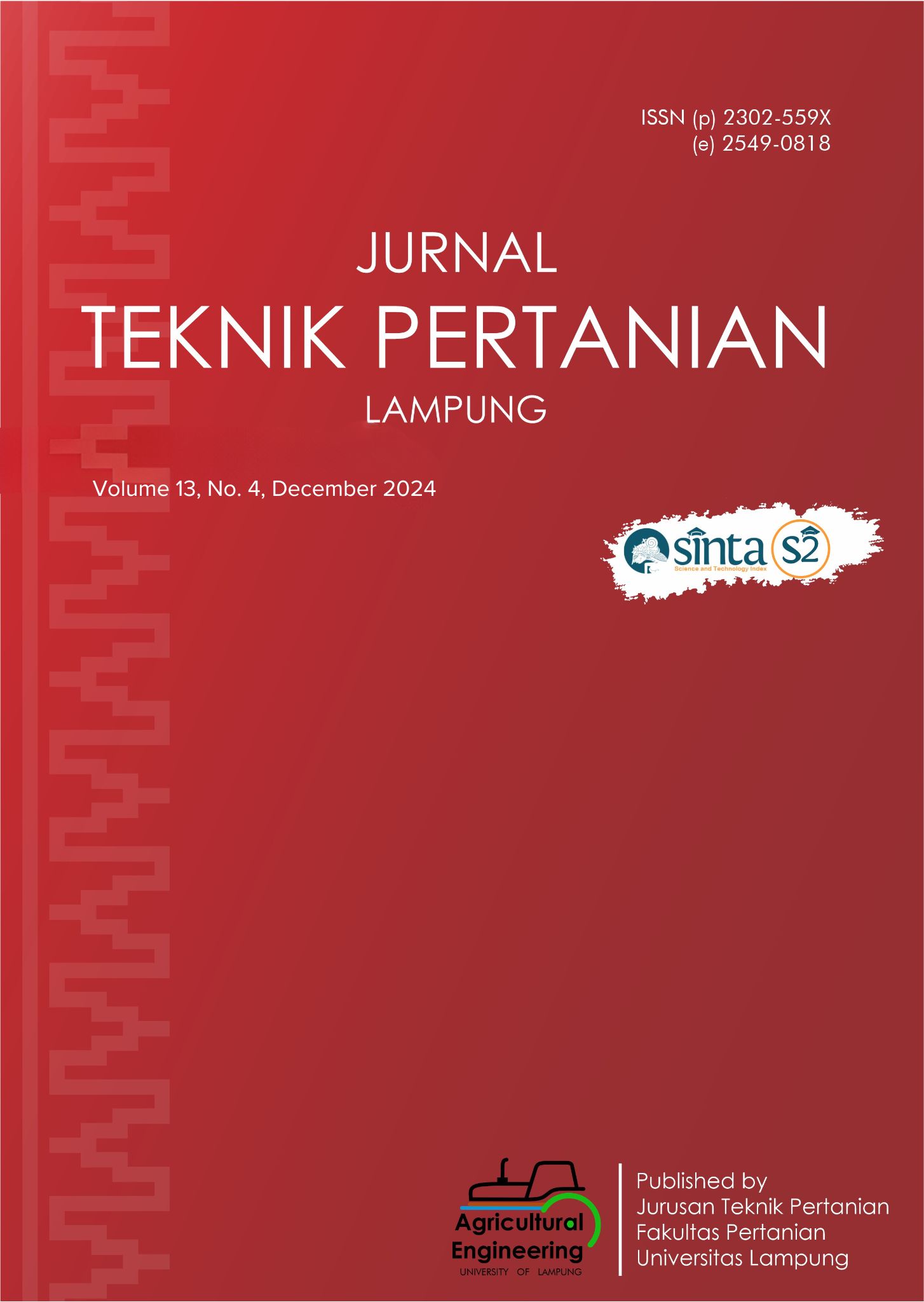Soil Physical Properties of Oil Palm Plantations in Tidal Areas of Peatland
DOI:
https://doi.org/10.23960/jtep-l.v13i4.1101-1108Abstract
Oil palm (Elaeis guineensis Jacq) is a plant with a higher vegetable oil content than other oil-producing plants, so palm oil is widely used as the main raw material for processed vegetable oil. The increasingly limited land area and the larger land area in Indonesia so that the space for plantation companies to expand the land is increasingly limited, so that the expansion of oil palm plantations began to change from optimal land to suboptimal land. Soil physical properties are properties related to the shape or original condition of the soil. This study aims to determine the physical properties of soil (texture, porosity, moisture content, soil color, particle density, and bulk density) on peatlands in the tidal area of PT Sinar Gunung Sawit Raya. This research used survey method with descriptive analysis. The soil samples taken were peat soil in the tidal area with purposive random sampling method at a depth of 30 cm. This research was conducted in November 2023 and continued in the laboratory for testing each soil physical properties. The results of the research on soil physical properties at PT Sinar Gunung Sawit Raya on peatlands in tidal areas show that the soil texture is loamy sand, soil porosity is good, moisture content is relatively normal, soil color looks relatively dark, particle density is still low and bulk density value shows low.
Keywords: Loamy sand, Oil palm, Peat soil, Soil color, Soil texture.
References
Abdul, K.S. (2020). Ilmu Tanah. PT. Raja Grafindo Persada. Jakarta.
Afrianti, S., Purba, M.P., & Napitupulu, K. (2019). Karakteristik sifat fisika tanah pada berbagai kelas umur tegakan kelapa sawit di PT. PP. London Sumatera Indonesia, Tbk Unit Sei Merah Estate. Agroprimatech, 2(2), 86-91.
Agus, F., Anda, M., & Jamil, A. (2016). Lahan Gambut Indonesia: Pembentukan, Karakteristik, dan Potensi Mendukung Ketahanan Pangan. IAARD Press. Jakarta.
Ariyanti, M. (2017). Sosialisasi teknik budidaya kelapa sawit berbasis perkebunan kelapa sawit berkelanjutan. Jurnal Pengabdian Kepada Masyarakat, 1(6), 356–360.
Haris, A., & Septiana, M. (2020). Dinamika Fe dan Mn di areal perkebunan kelapa sawit di lahan pasang surut Kabupaten Barito Kuala, Kalimantan Selatan. Prosiding Seminar Nasional Lingkungan Lahan Basah, 5(3), 85-87.
Haryanti, N., Marsono, A., & Sona, M.A. (2021). Strategi implementasi pengembangan perkebunan kelapa sawit di era industri 4.0. Jurnal Dinamika Ekonomi Syariah, 8(1), 76–87. https://doi.org/10.53429/jdes.v8i1.146
Lumbantoruan, S.M., Paulina, M., Siaga, E., Aggraini, S., & Febrianti, F. (2023). Growth response and nutrition uptake of corn plants on drought stress in peat soil. IOP Conf. Series: Earth and Environmental Science, 1160, 012020. https://doi.org/10.1088/1755-1315/1160/1/012020
Marbun, A.P., Walida, H., & Sitanggang, K.D. (2022). Karakteristik sifat fisika tanah pada tegakan kelapa sawit tanaman menghasilkan (Studi kasus di Kebun Rakyat Desa Perlabian Kampung Rakyat Kabupaten Labuhanbatu Selatan. Jurnal Mahasiswa Agroteknologi (Jmatek), 3(2), 35–42.
Maysarah, S., Nugroho, Y., & Susilawati. (2021). Analisis sifat fisika tanah pada lahan gambut di Kecamatan Liang Anggang Kota Banjarbaru Provinsi Kalimantan Selatan. Jurnal Sylva Scienteae, 4(1), 166. https://doi.org/10.20527/jss.v4i1.3104
Megayanti, L., Zurhalena., Junedi, H., & Fuadi, N.A. (2022). Kajian beberapa sifat fisika tanah yang ditanami kelapa sawit pada umur dan kelerengan yang berbeda (Studi kasus perkebunan sawit Kelurahan Simpang Tuan, Kecamatan Mendahara Ulu,Tanjung Jabung Timur). Jurnal Tanah Dan Sumberdaya Lahan, 9(2), 413–420. https://doi.org/10.21776/ub.jtsl.2022.009.2.22
Ratmini, N P.S., Juwita, Y., & Sasmita, P. (2018). Pemanfaatan biochar untuk meningkatkan produktivitas lahan sub optimal. Prosiding Seminar Nasional Lahan Sub Optimal, Universitas Sriwijaya, Palembang: 502–509.
Rauf, A., Supriadi., Harahap, F.S., & Wicaksono, M. (2020). Karakteristik Sifat Fisika Tanah Ultisol akibat pemberian biochar berbahan baku sisa tanaman kelapa sawit. Jurnal Solum, 17(2), 21–28. https://doi.org/10.25077/jsolum.17.2.21-28.2020
Darlita, R.R., Joy, B., & Sudirja, R. (2017). Analisis beberapa sifat kimia tanah terhadap peningkatan produksi kelapa sawit pada tanah pasir di perkebunan kelapa sawit Selangkun. Agrikultura, 28(1), 15–20. https://doi.org/10.24198/agrikultura.v28i1.12294
Sitohang, R.O. (2022). Kajian Karakteristik Fisik Tanah Gambut Pada Umur Kelapa Sawit yang Berbeda. [Undergraduated Thesis]. University of Jambi.
Soewandita, H. (2018). Kajian pengelolaan tata air dan produktivitas sawit di lahan gambut (studi kasus : lahan gambut perkebunan sawit PT Jalin Vaneo di Kabupaten Kayong Utara, Propinsi Kalimantan Barat). Jurnal Sains & Teknologi Modifikasi Cuaca, 19(1), 41–50. https://doi.org/10.29122/jstmc.v19i1.3112
Susilawati, A., Wahyudi, E.,& Minsyah, N. (2017). Technology development for sustainable tidal swamp land management. Jurnal Lahan Suboptimal, 6(1), 87-94.
Umin, M., & Anasaga, A.J.P. (2019). Karakteristik sifat fisik tanah pada lahan budidaya ubi kayu (Manihot Esculenta Crantz) di Desa Wologai Tengah. Agrica, 12(1), 23–33.
Winarna., Santoso, H., Sumaryanto., & Sutarta, A.D. (2017). Pertumbuhan tanaman kelapa sawit di lahan pasang surut. Pertanian Tropik, 4(1), 95–105.
Downloads
Published
Issue
Section
License
- Authors who publish with this journal agree to the following terms:
- Authors retain copyright and grant the journal right of first publication with the work simultaneously licensed under a Creative Commons Attribution-ShareAlike 4.0 International Lice that allows others to share the work with an acknowledgement of the work's authorship and initial publication in this journal.
- Authors are able to enter into separate, additional contractual arrangements for the non-exclusive distribution of the journal's published version of the work (e.g., post it to an institutional repository or publish it in a book), with an acknowledgement of its initial publication in this journal.
- Authors are permitted and encouraged to post their work online (e.g., in institutional repositories or on their website) prior to and during the submission process, as it can lead to productive exchanges, as well as earlier and greater citation of published work (See The Effect of Open Access).
Jurnal Teknik Pertanian Lampung

JTEPL is licensed under a Creative Commons Attribution-ShareAlike 4.0 International License.

